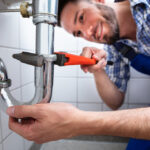There’s nothing more frustrating than coming home on a hot summer day, expecting a cool breeze from your air conditioner, only to find that it won’t turn on. This situation can be both uncomfortable and stressful, especially if you’re unsure what steps to take. The good news is that many common issues can be resolved without calling a technician. Here’s a detailed guide on what to do if your air conditioner won’t turn on, helping you diagnose and potentially fix the problem yourself.
1. Check the Thermostat Settings
The first thing you should do is inspect your thermostat. Make sure it’s set to “cool” and the temperature setting is below the current room temperature. It may sound simple, but sometimes someone else in the home may have adjusted it, or it might have been accidentally changed.
If your thermostat runs on batteries, try replacing them. Weak or dead batteries can cause your air conditioner not to receive the proper signal to start. Also, consider resetting your thermostat, especially if it’s programmable or smart. A software glitch might be the culprit.
2. Inspect the Power Source
Another basic but crucial step when figuring out what to do if your air conditioner won’t turn on is to check the power source. For central AC units, confirm that the circuit breaker hasn’t tripped. Go to your breaker panel and look for any tripped switches, especially the one labeled for HVAC or AC.
If you have a window or portable unit, ensure it’s properly plugged in and that the outlet is working. Try plugging in another device to test the outlet. If there’s no power, the issue could be with the outlet itself or the wiring.
3. Examine the Air Filter
A clogged or dirty air filter can block airflow, causing the system to shut down or fail to start. Locate your filter, usually found near the return air duct or inside the air handler, and inspect it. If it’s coated with dust or debris, replace it with a clean one.
Regularly changing your air filter—typically every 1–3 months—helps maintain your system’s efficiency and prevents breakdowns.
4. Look at the Condensate Drain Line
Many AC units have a safety switch that activates if the condensate drain line becomes clogged. This line is responsible for removing moisture from the system, and when it backs up, it can trigger a shutdown to prevent water damage.
Check for visible water around the indoor unit or in the drain pan. If you suspect a clog, you can use a wet/dry vacuum to try and clear the line, or contact a technician if the clog is persistent.
5. Check the Shut-Off Switches
Most air conditioning systems have a shut-off switch located near the indoor unit (often in the attic or basement) and another one outside near the condenser unit. If either of these switches has been turned off, your AC won’t run.
Make sure both switches are in the “on” position. It’s not uncommon for one to be accidentally flipped during cleaning or maintenance.
6. Inspect the Outdoor Unit
Your AC’s outdoor condenser unit should be clear of debris. Leaves, branches, or dirt buildup can interfere with the fan and coils, preventing the system from turning on. Also, check for any visible damage, disconnected wires, or strange noises.
Ensure that the disconnect switch near the outdoor unit is also in the “on” position. If your system uses a fuse-based disconnect, a blown fuse could be the issue.
7. Listen for Unusual Sounds
If your air conditioner makes a clicking noise but doesn’t turn on, the problem might be with the capacitor or the compressor. The capacitor helps start the motor and if it’s faulty, the AC won’t start properly.
While you can visually inspect the capacitor for signs of bulging or leaking, replacing it should be left to a qualified HVAC technician, as it holds an electrical charge and can be dangerous.
8. Consider the Age of Your AC Unit
If you’ve tried all of the above and your air conditioner still won’t turn on, consider its age. Most air conditioning units last between 10 to 15 years. If your unit is approaching or exceeding this age, it might be time to consider a replacement. Older systems are more prone to breakdowns and less energy-efficient than newer models.
9. Call a Professional
If none of these troubleshooting steps resolve the issue, it’s best to call a licensed HVAC technician. They have the tools and expertise to diagnose more complex issues like refrigerant leaks, motor failure, or electrical faults that are not safe or practical for homeowners to fix on their own.
An experienced technician can also perform a complete system check to ensure everything is working efficiently, potentially saving you money in the long run.
Final Thoughts
Knowing what to do if your air conditioner won’t turn on can save you time, stress, and potentially even money. Start with the basics—check the thermostat, power supply, and filters. Many issues are simple fixes, but for more complex or dangerous problems, don’t hesitate to contact a professional. Regular maintenance and seasonal checkups are also key to avoiding breakdowns in the first place, ensuring your home stays cool and comfortable year-round.






